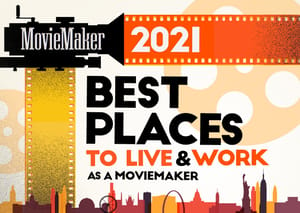
This year’s list of the Best Places to Live and Work as a Moviemaker is different than any we’ve done before, because never have so many moviemakers seriously considered changing their lives dramatically — starting with where they live.
Best Places Hall of Famers Los Angeles and New York City will always be our greatest movie cities, and the strong lockdowns they’ve instituted over the last year will make them stronger in the long run. But in the short term, they’re losing people to other great film cities, as many who have spent months inside insist on more space, lower housing costs, and more great outdoors.
And while the list of horrendous things about the pandemic seems endless, it has made the industry finally realize that it may not need so many in-person meetings, pointless pitch sessions, and meandering meals. We’ve all learned to be more efficient over Zoom than we are over coffee.
Believe us, we can’t wait to get back to face-to-face human contact. Some people are just more creative with other people around them.
So here’s to the world opening up again in 2021, and all of us taking the good things we’ve learned into the future… even as we leave other parts of last year far, far behind us.
Finally, we can’t stress enough: Please carefully assess the COVID-19 situation in any city or town you consider as a potential destination. Things are changing fast everywhere, so we urge you to supplement the information that follows — based on the longstanding reputations of the following locations — with the latest information on how they’re dealing with the pandemic.
HALL OF FAME
New York City
New York City suffered like almost no other last year, as COVID-19 hit early and hard. Already accustomed to close quarters, New Yorkers huddled indoors, masked up, and accepted the closure of Broadway, movie theaters, restaurants and many of the other greatest parts of our culture. But the pandemic didn’t break the Big Apple, because nothing can.
The best part of New York City is that it’s full of people with the heart, guts, and determination to try to make it in New York City. They’re drawn from all over the world, united by ingenuity and a belief in themselves. That will never change, even if lots of people may leave temporarily — and leave once-coveted apartments behind. There’s a huge opportunity for people ready to take their shot at the Big Apple, especially with the vaccine rollout underway.
In a normal year, the film and TV industry contributes more than $9 billion to New York City’s economy and employs over 130,000 people. It has some of the best film schools, festivals, and theaters in the world, and is home to filmmakers ranging from Martin Scorsese to Spike Lee to Woody Allen to Greta Gerwig. Prestigious organizations like Criterion, platforms like MUBI and Le Cinéma Club, and a host of small-scale distributors like Grasshopper Film, Cinema Guild and Factory 25 are all headquartered in New York City. A thousand issues of this magazine couldn’t contain all of NYC’s contributions to cinema.
Even in one of the worst years of its history, it dreams big: Over the summer, the NYC Economic Development Corporation and the Mayor’s Office of Media and Entertainment announced that Steiner Studios will establish a 500,000-square-foot production hub in Sunset Park to increase diversity and equity and create thousands of jobs. And the New York Film Critics Circle gave a special award to New York-based distributor Kino Lorber “for their creation of Kino Marquee, a virtual cinema distribution service that was designed to help support movie theaters, not destroy them.”
Yes, New York City has always been overrun by the very rich, who have driven up prices and made it a less accessible city to the not rich. It especially felt that way in the years just before COVID-19. But a lot of the very wealthy have left because of the virus, and, if we’re very lucky, the city may be more accessible to struggling artists because of it.
Los Angeles
These are trying times for Los Angeles. At the time of this writing, hospitals are very short on beds, and California has just lifted a weeks-long stay-at-home order.
But the TV and film industry has gone to extraordinary lengths to keep people safer on a film set than they would be in a restaurant or gym. Many productions are, at this moment, on pause. But the film and TV industry accounts for 164,000 jobs in Los Angeles County alone, roughly 46% of all film industry employment. Los Angeles is the gold standard and the default for the film industry: Assume that anything you like or dislike about American movies either originated or is strongly connected to L.A.
L.A.’s chief advantage — perfect weather — isn’t going to change anytime soon. And we don’t need to tell you about the beaches, beautiful people, great hiking, majestic theaters, outstanding film schools and festivals, and the pretty decent odds of seeing your favorite movie stars in person. Living in L.A., you will meet great collaborators, be constantly inspired, and perhaps even find people to give you money. It can feel like a paradise.
That said, in the years before COVID-19, traffic had started to make L.A. an occasionally exhausting place to live and work. If it can emerge from the pandemic with the lessons we learned about the value of working from home, L.A. may become a new, gloriously liveable place, revitalized and free of the gridlock that once wasted long stretches of our lives.
Continue for Moviemaker‘s Best Places to Live and Work as a Moviemaker, 2021
Share:

